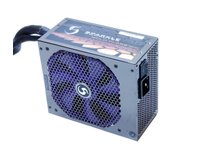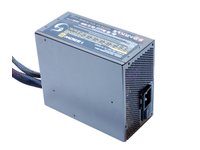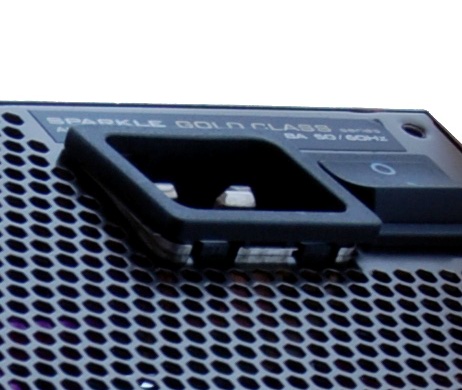Three 1000 W 80 PLUS Gold-Certified Power Supplies Tested
We received a trio of 1000 W power supplies priced between $200 and $300, so we ran them through our usual suite of tests to see if they really live up to their 80 PLUS Gold certifications. Surprisingly, all three hiccuped during efficiency testing.
Sparkle GW-EPS1250DA
The Sparkle GW EPS1250DA differs from its competitors in several ways. It is the most expensive, to start, with a price of $300. It's also the most powerful, delivering up to 1250 W. And it has a total of six 12 V rails. The power connector uses the rather unusual C20 connector, facilitating up to 16 A of current, so be sure to not forget your cable when going to a LAN party.
At first glance this all sounds quite reasonable, especially since the build quality and colors are convincing, if not for the fact that the power connector is rather loosely-connected to the PSU housing. Hopefully this is just a bad sample. Sparkle offers a five-year warranty, which is a redeeming point.
The length of the modular cables and number of connectors are more than sufficient, and three floppy connectors might actually almost be too many. The Sparkle GW-EPS1250DA has six 12 V rails, each rated at 20 A. The high number may very well mean that one will have a problem keeping track of the individual cables. Therefore, Sparkle prints color coded labels for the 12 V rails onto the unit.
However, this doesn't guarantee that the user will actually plug cables into the right places on the power supply, especially since all of the modular sockets have the same purple color. Therefore, there is a risk that one or two of the 12 V rails are under heavy load when the others aren't. We could not reach the theoretical maximum of 120 A over the six rails in our tests, since the voltage of the individual 12 V rails was already below the ATX specification limits at 113 A. Obviously, this PSU has no power reserves left.
| Sparkle GW-EPS1250DA | Header Cell - Column 1 | |||||||||
|---|---|---|---|---|---|---|---|---|---|---|
| AC Input | 90-264 V, 50-60 Hz | Row 0 - Cell 2 | Row 0 - Cell 3 | |||||||
| DC Output | +3.3 V | +5 V | +12 V (#1) | +12 V (#2) | +12 V (#3) | +12 V (#4) | +12 V (#5) | +12 V (#6) | -12 V | +5 Vsb |
| 30 A | 30 A | 20 A | 20 A | 20 A | 20 A | 20 A | 20 A | 0.6 A | 3.0 A | |
| Individual Output | Row 3 - Cell 1 | Row 3 - Cell 2 | Row 3 - Cell 3 | Row 3 - Cell 4 | Row 3 - Cell 5 | Row 3 - Cell 6 | Row 3 - Cell 7 | 7.2 W | 15 W | |
| Rail Utilization | Sys | Sys | CPU & VGA | |||||||
| Combined Output | 170 W | 1250 W | ||||||||
| Total Continuous Output | 1250 W | |||||||||
| Peak Output | 1440 W |



Get Tom's Hardware's best news and in-depth reviews, straight to your inbox.
Current page: Sparkle GW-EPS1250DA
Prev Page Rosewill Lightning-1000: Measurements Next Page Sparkle GW-EPS1250DA: Measurements-
killbits hmm, maybe next time include a super-high-end psu that doesn't suck.Reply
http://www.newegg.com/Product/Product.aspx?Item=N82E16817139014
takes any of the psu's in this review to school. -
mr_cb7 Replyhmm, maybe next time include a super-high-end psu that doesn't suck.
Seriously where is PC Power & Cooling,Corsair, or Antec!
OCZ and Rosewill thats it? OCZ is alright, but Rosewill is crap.
try theses next time:
http://www.pcpower.com/power-supply/turbo-cool-1200.html (not GOLD I know but still)
http://www.newegg.ca/Product/Product.aspx?Item=N82E16817139014
http://www.ncix.com/products/?sku=56794&vpn=HCP-1200&manufacture=Antec -
one-shot I have a 750W Corsair PSU. When gaming with my i7 920 @ stock and SLI GTX 260s, I haven't come close to 400watts, according to my UPS. If you take the number the UPS gives and factor in the efficiency of the PSU, the power draw is much less. I've seen up to 360 watts with TF2 and Test Drive Unlimited 2 so far. Although running burn tests on GPUs and CPU will draw much more.Reply
Running Bionc on CPU and F@H on both GPUs, I draw 441 watts with ALL components under HEAVY load. That's 100% on all CPU threads and GPUs. 1000W is enough for a lot of components.
I also idle at 189 Watts with SLI enabled. -
Chewie Call me a noob if you like, but I didn't realise using 230V was more efficient 115V. I guess that's a bonus for those of us down under.Reply
I just wish I could afford the kind of components that would require this kind of PSU. -
alidan ChewieCall me a noob if you like, but I didn't realise using 230V was more efficient 115V. I guess that's a bonus for those of us down under.I just wish I could afford the kind of components that would require this kind of PSU.Reply
can someone explain this to me, because i dont get it. -
tuhinz Reply9509055 said:can someone explain this to me, because i dont get it.
Its got to do with varying efficiency at different voltage levels.
Consider the following:
Power(P) = Voltage(V) X Current (I) X Power factor (Cos phi)
Now for the same amount of power transfer, at lower voltages, the current required is more (See the equation below):
P = V1 X I1 X Cos phi1 = V2 X I2 X Cos phi2
(Substitute for V1 = 230, V2 = 115, neglect the slight difference in Cos phi1 & Cos phi2)
The losses are given by :
H =I^2 X R X t (where R is the resistance of the current carrying conductor, t is time)
Thus losses increase in proportion to the current squared.
So you have higher losses (hence lower efficiency) at lower voltages. -
jimishtar "Max. temperature difference air intake to outlet - less is better "Reply
where's the logic in this?
bigger temp difference means the cooling system is more efficient and it takes the heat away from the components. why is air temp so important to you? If you cannot measure temp from inside the psu case (the components) why bother with air temp? -
tuhinz Reply9509057 said:than why can you switch between? thats what im not understanding.
You can't switch between the two. US & Japan & some S. American countries (IIRC) use 115V while the rest of the world uses 230V. PSUs meant for both markets often have a switch and you need to set it to the correct voltage for your country and plug it in. Many modern PSUs will often have a large input voltage range spanning both the voltage levels so you won't find the switch in them (My Corsair TX650 for instance).

